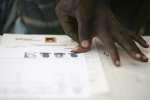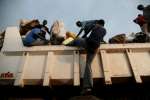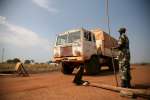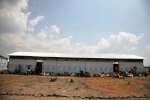Making way for more refugees
News Stories, 10 August 2001

GENEVA, Aug. 10 (UNHCR) – In anticipation of more new arrivals, an estimated 8,000 returning refugees in three transit centres in the Sierra Leone capital of Freetown have been asked to move from the premises to resettlement sites, the U.N. refugee agency said Friday.
The returnees came home in November of last year following fighting in refugee camps in neighbouring Guinea where they were living. The majority are from the Kono tribe and they are reluctant to move from the Jui, Waterloo and Lumpa transit centres because their home territory in Sierra Leone is still considered unsafe.
UNHCR has been organizing convoys to resettlement sites in the east and south of the country and a new site at Taiama will open next week so the returnees can be as close to their homes as possible.
The number of refugees returning by ship from the Guinea capital of Conakry to Freetown has dropped in the past several months after the security situation in Guinea improved, but the refugee agency will shortly start facilitating the return of more refugees who decide to go home, even though the situation in parts of the country remains difficult. Of the more than 56,000 Sierra Leoneans who have gone back in the last year, only 4,300 have been able to go back to their homes. The rest live in resettlement sites.
Related stories by:
- Palestinian refugees arrive at Romania centre en route to resettlement
- Emergency transit centre in Romania sets precedent for other countries
- UNHCR helps Congolese refugees return home across Lake Tanganyika
- Sierra Leonean refugees in Guinea advised on end of their status
- UNHCR resumes return operation for displaced in northern DRC
UNHCR country pages
Sierra Leone: Last Return Convoy from Liberia
On July 21, 2004, the final UNHCR convoy from Liberia crossed over the Mano River bridge into Sierra Leone with 286 returnees. This convoy included the last of some 280,000 refugees returning home after Sierra Leone's brutal 10-year civil war which ended in 2000. Overall, since repatriation began in 2001, UNHCR has helped some 178,000 refugees return home, with a further 92,000 returning spontaneously, without transport assistance from UNHCR.
UNHCR provided returnees with food rations and various non-food items, including jerry cans, blankets, sleeping mats, soap and agricultural tools in order to help them establish their new lives in communities of origin. To promote integration of newly arrived returnees, UNHCR has implemented some 1,000 community empowerment projects nationwide. Programmes include the building and rehabilitation of schools, clinics, water and sanitation facilities, as well as micro-credit schemes and skills training.
UNHCR and its partners, alongside the UN country team and the government, will continue to assist the reintegration of returnees through the end of 2005.
Sierra Leone: Last Return Convoy from Liberia
South Sudan: The Long Trip Home
When the peace treaty that ended 21 years of civil war between north and south Sudan was signed in 2005, some 223,000 Sudanese refugees were living in Uganda – the largest group of Sudanese displaced to a neighbouring country.
Despite South Sudan's lack of basic infrastructure, such as schools, hospitals and roads, many Sudanese were eager to go home. In May 2006, the UN refugee agency's Uganda office launched an assisted repatriation programme for Sudanese refugees. The returnees were given a repatriation package, including blankets, sleeping mats, plastic sheets, mosquito nets, water buckets, kitchen sets, jerry cans, soap, seeds and tools, before being transported from the transit centres to their home villages. As of mid-2008, some 60,000 Sudanese living in Uganda had been helped back home.
As of the beginning of May 2008, some 275,000 Sudanese refugees had returned to South Sudan from surrounding countries, including Uganda, Ethiopia, Central African Republic, the Democratic Republic of the Congo and Kenya. Some 125,000 returned with UNHCR assistance.
Posted on 16 July 2008































